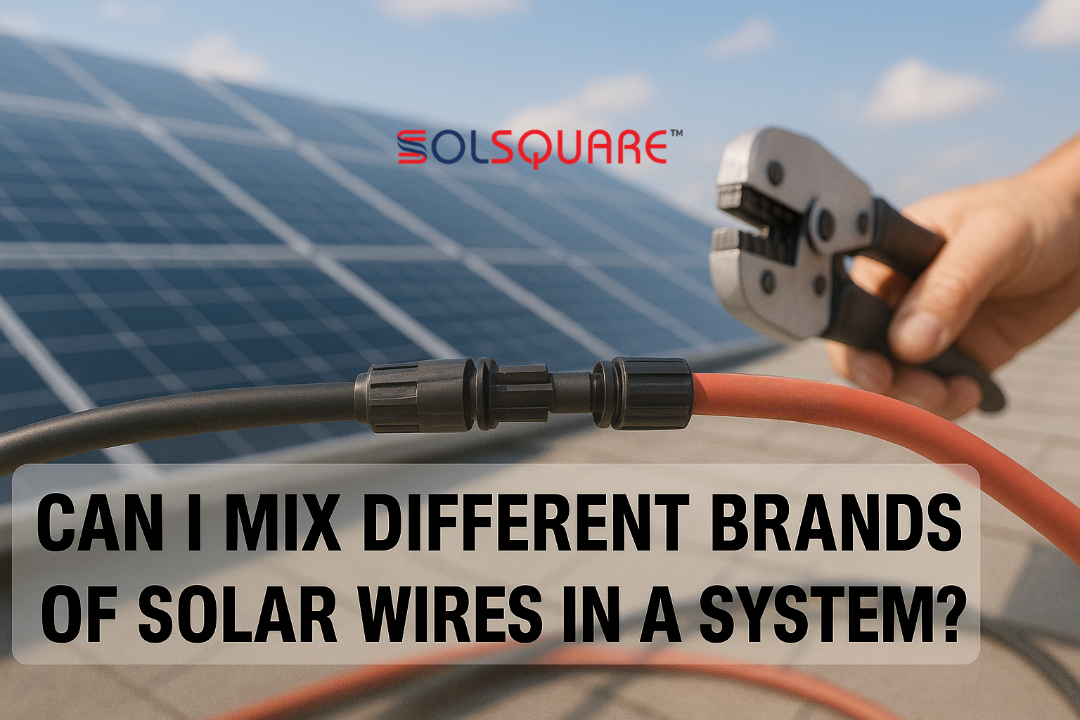Can I Mix Different Brands of Solar Wires in a System?
Here’s What You Should Know, Considering throwing a batch of old solar wires of mismatched brands in your system? The guide simplifies why it is safe or not, when it is safe, and what dangers you will want to monitor so that you make the correct decision on your solar system.

Introduction
Suppose you mounted a little solar system on your roof last year. Now you want to expand it, and you still have some leftover solar cable from another brand. Of course, the question arises—"Can I combine these wires with the new ones?"
It is the common case of homeowner, DIY solarists, and even little installers. Cables are expensive and reusing the old ones is quite a rational and environmentally nice approach. However in the case of solar wiring, everything is not black and white.
Appropriate solar wiring is important. These carry high currents from your panels to the inverter and batteries, day after day. An inferior connection or mismatch would introduce performance problems—or even worse, a safety hazard.
So, let's discuss if combining solar cable brands is a safe bet or a no-go.
Why This Question Matters
We get it—solar cables look the same. Same black or red sheathing, similar labeling, same copper inside. If each wire is certified to 1.5 kV and properly thicknessed, what is the harm?
The reality is, combining solar wires of different brands may appear harmless, but technical as well as safety concerns exist. Compatibility is not all about voltage and current—it also involves how the materials react over time, under stress, and in extreme weather conditions.
And then, of course, there's the warranty issue—some manufacturers require that certain cables or brands be used in order to retain the warranty. If something does fail, you don't want to have finger-pointing between suppliers.
With so little clear advice out there, it's no wonder so many are confused about what to do.
Are Solar Wires Brand-Specific?
Solar wires are not similar to mobile phone charger where brand A does not fit or run with brand B. Most solar cables are technically the same, in that they may have ISI, TUV or IEC certification etc, as in India standards are becoming more and more strict.
But that doesn’t mean every wire is equal.
Different brands might use:
- Higher or lower grade copper
- Thicker or thinner insulation
- Varying levels of UV resistance or weatherproofing
- Different tolerances for heat and current
Suppose you fitted four tires on your car. Yes, they may be all equal in size, but what about high speed or when it is wet on the road? The vehicle will not perform well, and the tires will get worn out unproportionally. The same intuition is true with solar wiring.
What Can Go Wrong If You Mix Brands?
Let’s say you're mixing two cables—same gauge, same voltage rating. Should be fine, right?
Not necessarily.
If one brand uses higher-purity copper and the other uses recycled or low-grade copper, you’ll get uneven conductivity. This could lead to:
- Voltage drops
- Inconsistent current flow
- Overheating
- Reduced solar output
- Premature cable degradation
A real example? A homeowner in Pune, Maharashtra added two new solar panels to his system and reused leftover wire from a different brand. Within months, he noticed the junction box heating up and a burnt smell from the conduit. It turned out one cable had much thinner insulation, which couldn’t handle the heat. The electrician had to replace the section—and it voided part of the inverter warranty.
When (and How) It Might Be Acceptable
Okay, so is mixing solar cable brands always a bad idea?
Not exactly. There are situations where it might be fine—as long as you meet certain conditions:
- The wires are identical in spec: same voltage rating, same ampacity, same insulation standard.
- Both cables are certified (ISI, TUV, IEC).
- The wiring is installed properly and tested by a certified electrician.
Nevertheless, it is not something you can do carelessly. Although it may be functional in the present, this may bring problems in future. If you are not sure ask your installer. Safety first is always good.
Expert Recommendation
This is what most solar electricians can tell you and that is to use one brand of cable throughout your system wherever feasible.
Not only appearance, but also consistency in the performance, safety and trouble-shooting with less effort. By using a single brand you trust, you are well aware of how it performs, wears, and behaves.
and no dazzling titles. A lesser-known brand having good certificate and quality of copper is preferred to a well-known cable cut cornering.
Brand popularity should not be in front of quality, consistency, and certification.
FAQs
Conclusion
A mix of solar wire brands may seem like a harmless shortcut—but often, it is just not worth the risk.
Okay, technically it could be done, but under very restrictive situations. A wiser choice is to maintain a consistent wiring pattern throughout.It spares you a load of headaches, safety concerns and costly re-do.
Don not attempt to do it yourself, in case of doubt consult a professional. Solar is a long-term investment, therefore, accord it the attention it requires.